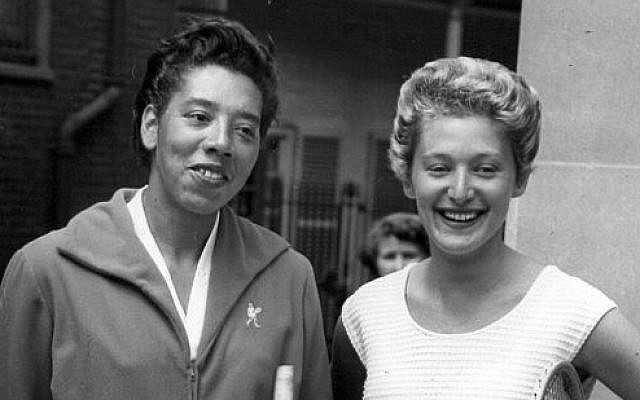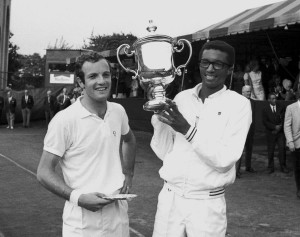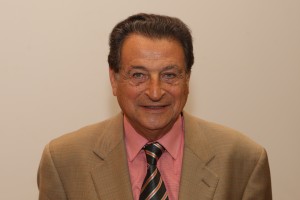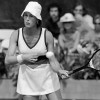by Randy Walker
@TennisPublisher
On September 1, 1977, one of the most sensational events happened in the history of the U.S. Open. As documented in my book “On This Day In Tennis History,” Renee Richards, the 43-year-old transsexual who fought for more than year for the right to play in the women’s singles competition at a major tennis championship, was beaten in the first round by Wimbledon champion Virginia Wade, 6-1, 6-4. Barry Lorge of the Washington Post described the match as a media event as “a swarm of photographers, broadcasters and reporters were on hand to record the details of what was purposed to be a grand gesture for human rights by some, and a freak show by others.”
It was only two weeks earlier on August 17, 1977, where the United States Tennis Association was basically forced to accept Richards into the women’s field at the U.S. Open, as excepted below from the aforementioned book:
The United States Tennis Association rules that 43-year-old transsexual Renee Richards will be allowed to play in the women’s singles championships at the U.S. Open. The USTA statement issued on the day reads, “For the past year, the USTA has been confronted with the difficult problem of balancing consideration for an individual transsexual with considerations of fairness for women tennis players in general, especially the lower-ranked players. On the basis of medical authority, the USTA has had reason to believe that a postoperative transsexual may retain some physical and competitive advantages. It appeared to the USTA that a generally accurate, easily administered and objective test, such as the Olympic type chromosome test, was a desirable screening process in determining sex for the purpose of athletics. The New York State Court ruled in favor of an individual transsexual and places restrictions on the use of the chromosome test. As a result of this proceeding, the USTA will accept Dr. Richards as an entrant into the U.S. Open tennis championships.”
The legal decision came down the day before, on August 16, 1977, as reported by Neil Amdur in the New York Times. Wrote Amdur, “State Supreme Court Justice Alfred M. Ascione issued a preliminary injunction yesterday barring the United States Tennis Association, the United States Open Tennis Championship Committee and the Women’s Tennis Association from excluding the 42-year-old transsexual from the world’s richest tournament because of her inability to pass the Barr body test.”
Amdur reported that it was a 13-page decision “that could become a landmark” in that Ascione ruled that having to subject Richards to a test in order to play in the U.S. Open was “grossly unfair, discriminatory and inequitable, and violative of her rights under the Human Rights Law of this state.”
“It seems clear that defendants knowingly instituted this test for the sole purpose of preventing plaintiff from participating in the tournament,” wrote Ascione. “The only justification ‐ for using a sex‐determination test in athletic competition is to prevent fraud, i.e., men masquerading as women competing against women.”
Despite the loss to the No. 3 seeded Wade, Richards reached the doubles final partnering with Betty Ann Grubb Stuart (the mother of future U.S. pro Taylor Dent), losing to Martina Navratilova and Betty Stove, 6-1, 7-6. (Watch here: https://www.youtube.com/watch?v=2MSbUODDccU)
Wrote Bud Collins in his volume “The Bud Collins History of Tennis” of the episode, “Transsexual Renee Richards won her year-long legal struggle for acceptance in women’s tournaments when a New York judge ruled that she could not be barred from the U.S. Open for failing the Olympic chromosome test. The court ruled that medical evidence proved Richards was “female,” and the USTA and WTA dropped efforts to bar her. She lost in the first round of the Open singles, but reached the doubles final with Californian Betty Ann Grubb Stuart before losing to Navratilova and Stove, 6-1, 7-6. Thereafter, Richards—the lone entrant to use both men’s and women’s dressing rooms at the U.S. Championships—became a regular competitor on the women’s circuit, though several players defaulted against her in protest. Renee lost to Wimbledon champs in her Forest Hills ventures: To Neale Fraser, 6-0, 6-1, 6-1, in 1960, and Wade, 6-1, 6-4 in 1977, both first rounders. She did win a minor tournament, Pensacola, Fla., defeating Evert in the semis (Jeanne Evert, that is), 6-1, 4-6, 6-2, and Caroline Stoll in the final, 6-2, 6-2.”
As Sandra Harwitt wrote in her chapter on Richards in her book “The Greatest Jewish Tennis Players of All Time,” Richards considered living a low-profile life in California, but “tennis was essential in her life” and she wanted to play competitively.
“Tennis was a refuge because it’s something that I love to do, and it was something that I was good at and I could have success at doing. And it was so clear-cut — the geometry of a tennis court and you against your opponent,” Renee said on the NPR “Talk of the Nation” radio show.
Wrote Harwitt, “It was after she played in and won a women’s tournament in La Jolla, California where she was discovered that she was indeed a former man playing in the women’s event.”
Gene Scott, an old friend and fellow student at Yale of the former Richard Raskin, invited Richards to compete in the WTA tournament he was promoting and directing, the Tennis Week Open in South Orange, N.J. However, when it was announced that Richards would be playing in the event, 25 of the 32 entrants in the tournament withdrew in protest. Richards reached the semifinals at the event.
“At the Orange Lawn Tennis Club last week, reactions to Richards’ crusade seemed to ricochet about like volleys across the sex barrier, veering from astonishment to suspicion, sympathy, resentment and, more often than not, utter confusion,” wrote Ray Kennedy in Sports Illustrated as seen here https://vault.si.com/vault/1976/09/06/shed-rather-switchand-fight






